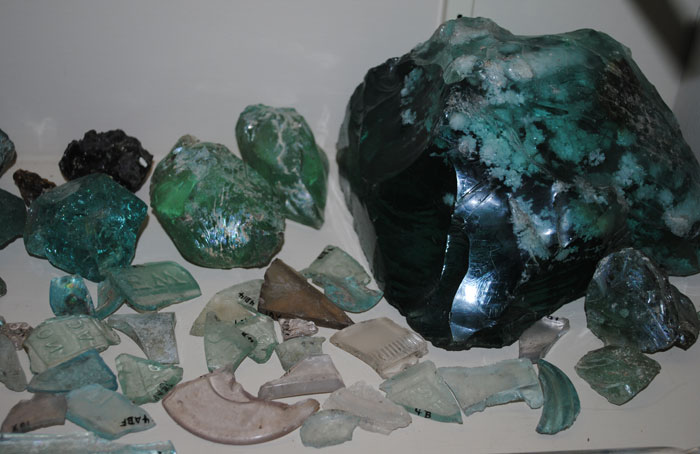
Towns & Industry (1860-1880)John Herring's Glass Factory |
|||
|
|||
Cullet, Napanee Glass Factory |
Napanee's prominent industrialist, John Herring, was born February 17, 1818 in Lewis County, New York, where he worked as a builder and teacher before immigrating to Kingston, Ontario in 1841. He ultimately settled in Napanee in 1843. DISCOVER MORE![]()
Herring opened a foundry, specializing in the manufacture of reapers, mowers, ploughs, and domestic cook stoves. His prominence in the community lead Herring to local politics in 1860, and he served as a town councillor, and eventually held the office of Reeve. In 1863, he secured the contract to build a new public school for the community, West Ward Academy. He also engaged in brick and potash making, and was heavily involved in lumbering and the paper industry. By 1872, he shared ownership of a paper mill upstream along the Napanee River. When the Napanee Gas Company faced financial difficulties, Herring bought the company in 1876, reorganizing it into a successful business, and supplied the town with petroleum for lighting.
Herring's most ambitious undertaking was the Napanee Glass Works. In the wake of the 1878 Federal Election, a high protective tariff was imposed on American goods, including glass imports, as part of Sir John A. McDonald's National Policy. With the cost of importing glass raised considerably, Herring believed he could outsell his American competition. In 1881, Herring began travelling to glass houses in Syracuse and Pittsburgh to research glass production. Upon returning to Napanee, Herring purchased twelve acres of land north of the Grand Trunk Railway.
On June 2, 1881, ground was broken on the glass factory, and the factory officially opened the second week of November. To celebrate, the Napanee Beaver published an article on glass making and the Herring Glass Factory, including a hand drawn diagram of the factory's layout, highlighting more than fourteen buildings. Best estimates suggest a factory of that size would have had roughly thirty employees, and produced $33,000 in finished glass per year. Herring brought glass makers from Germany, Belgium, France, and England to train his workforce. The factory produced fine window glass, but workmen often indulged in whimsies, producing canes, candlesticks, glass hats, bowls, pitchers, and various glassware. The delicate serpent's cane is one solid piece of green coloured glass, with blue, white and gold lines in a spiral around the glass, which leads to a pointed tip at its tail, and a serpent's head at the top of the cane. The only known image of the factory appears in the background of a West Ward Academy photograph taken in 1883.
By the end of 1883, the factory had gone out of production, and remained closed despite attempts by Herring to resume production in 1884. Napanee's Mayor, H.L. Cook began negotiations with an English manufacturer in 1888 to revive the industry, but the bid was unsuccessful. The factory is thought to have failed for several reasons. For one, specialized union workers from the United States demanded union wages. Labour problems also persisted, and a master glassblower from Pittsburgh was said to have been fired for incompetence. Moreover, the world was experiencing a trade depression, and demand simply waned. The N.T.Q. Railway provided another obstacle, laying a track that cut off entrance to the factory. Although Herring sued, the financial burden of the Glass Works was too great for him to bear alone, and he ultimately sold the property to N.T.Q. in 1889 for $2,500 to use for freight sheds.
A portrait of Mr. Herring was taken by Napanee's J.S. Hulett, a local photographer active from 1870 to 1900.
Despite the failure of the Glass Works, Herring remained a respected member of the community when he passed away on October 21, 1896 at the ripe old age of 80.
© Lennox & Addington County Museum & Archives
97 Thomas Street East, Napanee, Ontario, Canada K7R 4B9
Funding provided by the Government of Ontario and the County of Lennox & Addington




